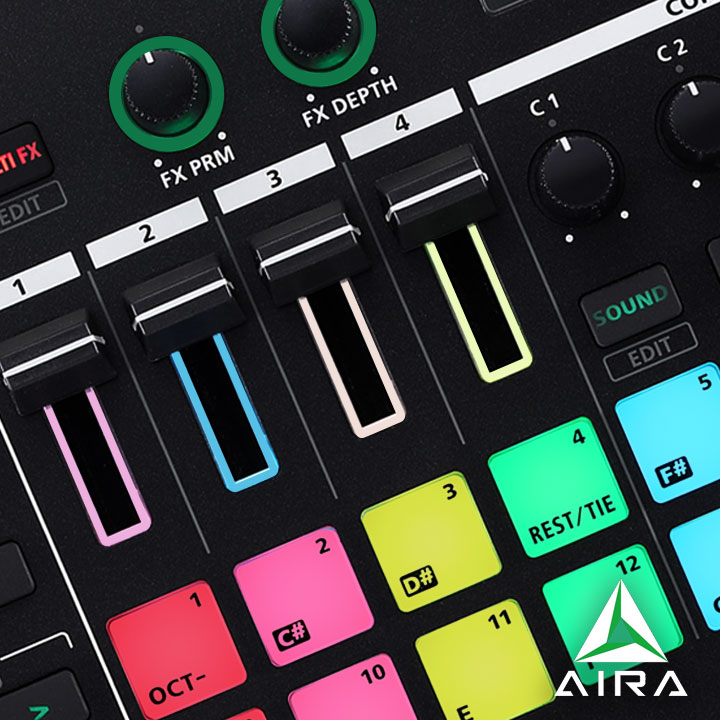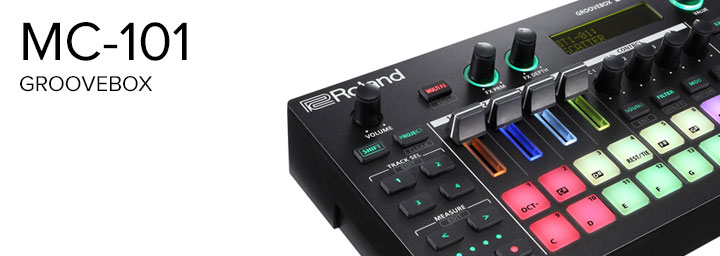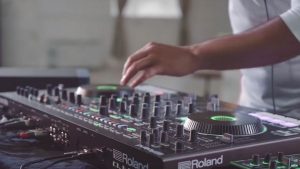The Roland MC-101 is a compact four-track Groovebox featuring the high-quality sounds, sequencing and effects of its bigger sibling the MC-707. It’s a pocket production studio that allows you to create whenever inspiration strikes you.
This reference guide has everything you need to know to get started writing your own original tracks on the MC-101!Table of Contents
- Creating a Project/Track
- Using Drum Tracks / Sequencing Drums
- Sequencing Melodies & Notes
- Changing Tempo
- Using Transpose
- Quantize / SH-101 Style Sequencing
- Saving Projects
- Working with Clips
- Working with Scenes
- Motion Designer
- Using Motion/Automation
- First and Last Step
- Editing Tones/Effects/Drums
- Using Drum & Comp Tracks
- Using Scatter
- Master FX
- Importing Samples / Sampling over USB
- Resampling
- Using Looper Tracks
- Changing Tones Per Clip
- Deleting Tracks
- System Settings
- Update to version 1.5 for more sounds and more functions!
1. Creating a Project/Track on the MC-101
Before we dive in, let’s take a look at how to get up and running on the MC-101. In the Project video below, learn how to create a new project from scratch, as well as change project parameters such as the overall project volume. The second video dives into the 3 main types of tracks you can create on the MC-101. Tone (Synth), Drum and Looper (Sampling) Tracks. Tone Tracks are great for creating melodies and using various synths. Drum Tracks give you access to the wide range of percussion sounds and samples on the MC-101, while Looper Tracks allow you to import your own audio loops or samples.
2. Using Drum Tracks / Sequencing Drums
Now that your project and tracks are setup, we can start sequencing beats. Learn how to use and sequence Drum Tracks on the MC-101. The Advanced Drum Sequencing video dives into parameters such as sub-steps that are unique to Drum Tracks.
3. Sequencing Melodies & Notes
Learning how to experiment with sequencing notes and melodies is the next step. The MC-101 is equipped for both real time recording, as well as tapping in your own step-sequences on the grid. It can also record polyphonically, meaning that chords you have in mind can also be recorded or sequenced.
4. Changing Tempo
The tempo of a project, or BPM, can drastically change the tone, feel and even genre of a track. For that reason, this video will quickly teach you how to change BPM on the MC-101.
5. Using Transpose
Transpose is another valuable bread and butter tool to have at your disposal. Like tempo changes, switching the key signature your track is in can shift its mood completely. It can also frame your song in a new light. This is useful if you have writers block or aren’t sure what direction to take your track.
6. Quantise / SH-101 Style Sequencing
Quantization can lock your (almost perfect) recordings into time. They can also be a creative tool to push your sequences in rhythmically interesting directions. Regardless, let’s look at the different ways to Quantize on the MC-101.
The SH-101 Style Sequencing video takes a look at how to sequence tracks step-by-step in the style of the famous Roland SH-101 Synthesizer from 1982.
7. Saving Projects
This function is self-explanatory but, nonetheless, a very important one to learn. Make sure to save your projects regularly so you don’t lose valuable progress!
8. Working with Clips
Learning to work with clips is where sequences evolve into full tracks. Wrapping your head around clips on the MC-101 will allow you to create variations of existing loops, and entirely different sections for you to switch to on the fly. This is useful as a creative tool while writing, for instance, layering tracks in ways you might not have thought of initially. It’s also invaluable for live performances.
9. Working with Scenes on the MC-101
Scenes are specific configurations of clips that you can save and recall for later. This is particularly useful during performances. For instance, if you want to experiment or improvise but want the peace of mind that you can always restore clips back to how they were when you saved the scene. It also allows you to create distinct sections of your song to jump to, for instance separate Verse/Chorus sections, or a Drop/Breakdown.
10. Motion Designer
Adding motion or automation data to a track is a valuable tool to have in your arsenal. It’s an excellent way to add movement to a song if it needs variation. Motion Designer on the MC-101 works by overlaying an LFO (Low Frequency Oscillator) as Motion Data to effect parameters such as the Sound Knob, Filter Knob or Modulation Knob.
11. Using Motion/Automation
In the MC-101, automation is known as “Motion”. You can live record and then edit Motion data for many different parameters – such as the Sound, Filter, Mod and FX Knobs. It’s a great way to add live movement and variation to your tracks.
It’s really easy to record motion on the MC-101; simply hold the [SHIFT] button and then press the [MOD] button, and then turn Motion On. Then simply press record, and your motion parameters will be recorded in real time!
12. First and Last Step
First and Last Step is a real-time manipulation tool on the MC-101. It allows you to adjust the range in which your sequences loop. This allows for interesting rhythmic experimentation. Try taking a tone or drum track and setting the First and Last Step to an odd number.
13. Editing Tones/Effects/Drums
These videos break down the great range of editing capabilities you have when working with the tones, effects and drums onboard the MC-101. Specific parameters such as Mono/Poly Modes and Attack are covered for Tones. Multi-Effects settings like Chorus, Delays and Distortion are also demonstrated, as well as how to tweak settings for individual Drum Pads.
14. Using Drum & Comp Tracks
Drum & Comp is a unique track type on the MC-101 that gives you a Drum Track with 6 individual busses with compressors. This is very useful if you want a lot of mixing control with your drums, as you can send individual sounds to different compressors. This video demonstrates how to get started using Drum & Comp tracks.
15. Using Scatter with the MC-101
Scatter effects are great for fills and transitions during live performances, but also creative inspiration while writing.
Scatter for Songwriting
Experimenting with Scatter tools while you’re writing can help inspire you and allow you to hear your layers in ways you may not have come up with organically. Hearing your track rhythmically warped, for instance, might give you an idea for a fill you can incorporate into the song.
Scatter for Live Performance
Scatter effects are both creative and fun tools to use in a live setting. They’re a great way to create varied fills on the fly that aren’t programmed into the track. You can also, for example, improvise breakdowns and whole new sections to give your performance an organic edge.
This video teaches you about how to access the scatter function in the MC-101, as well as how to tweak individual scatter effects to suit your needs.
16. Master FX
In this video we’ll take a look at the many Master FX that you can apply to your track. Effects such as the Lo-Fi Compressor, EQ and Filters are covered among others. Master FX are useful for experimentation during a performance, writing fills and transitions for a track, or while mixing/mastering a song.
17. Importing Samples / Sampling over USB
The MC-101 has a huge range of classic and modern sounds available to you right out of the box. In these videos, however, we take a look at how to import your own samples via SD Card, Sampling over USB as well as how to resample your track. These are especially useful if you have tracks you want to import into the MC-101, or if you want to write tracks using your existing sample library.
18. Importing Samples / Sampling over USB
Resampling is the process of recording your track that you can then sample or use creative effects on for. It’s also an extremely powerful tool on the MC-101, as it allows you to record your song or a section of it onto an individual track. From here, your other tracks are freed up to then add more layers. As a result, you can work around the limitations of 4 tracks.
19. Using Looper Tracks
Looper tracks allow you to import your own audio loops or samples for your compositions. This video breaks down why they’re useful on the MC-101, and how use time-stretching and other effects on Looper tracks. Each track contains a powerful sampler, so you can import your own custom sounds. Use your own voice, or the sound of your favorite instrument from your computer. Imported audio can then be synced to the MC-101’s tempo or be processed with the arsenal of built-in effects and controls.
20. Changing Tones Per Clip on the MC-101
One really exciting feature you may not be aware is possible is the ability to change tones per clip! The MC-101 allows you to use different sounds for each clip using only one track. Learning how to do this then allows you to get the most out of each of the 4 tracks onboard and increase the sonic scope of your tracks dramatically!
21. Deleting Tracks
If you need to start an idea from scratch or decide a layer just isn’t quite sitting correctly, this video teaches you how to delete tracks using the clear function on the MC-101.
22. System Settings
Finally, let’s take a look at how to access the System Settings in the MC-101. Global Parameters can be found in the Utility Window. This video shows you how to edit parameters such as Pad Trigger Sensitivity, USB Audio FX Routing and MIDI Settings.
23. Update to version 1.5 for more sounds and more functions!
The new v1.50 update expands your MC-101 library with support for our ZEN-Core Sound Packs, an ever-growing collection crafted by some of the world’s top sound designers. These sounds leverage the power and flexibility of the ZEN-Core Synthesis System to deliver an incredible array of tones—from analog-modeled synths to crystal-clear pianos—with new installments added regularly to keep your music sounding fresh.
https://www.roland.com/au/promos/zen-core/sounds/
And to make use of all these new sounds, there is now an increased number of available Scenes! 128 in fact for even more flexibility in live arranging.
Version 1.50 update also brings powerful features ported from the MC-707, including Chord Designer for per-pad chords with key, scale, root, and spread parameters; Sample Edit functions like truncate, loop, pitch, gain change, and playback mode; and Note Utility to change the timing and transposition of all notes within a clip.
You can download the v1.50 update from the MC-101 Downloads pages.
➤ UPDATE MC-101: https://www.roland.com/au/products/mc-101/downloads/







